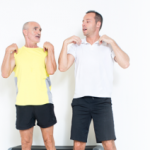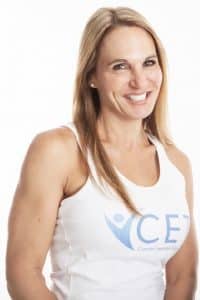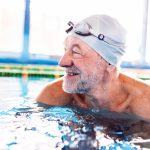Customized Exercise Programming for Osteosarcoma (Bone Cancer)
 Jeff received a referral for a client with bone cancer. He’s been a Cancer Exercise Specialist for a year, but this is his first client with bone cancer. He asked if he could hire me to help him with and teach him how to put together Stan’s exercise program. He completed his initial assessment and health history and shared the following information with me:
Jeff received a referral for a client with bone cancer. He’s been a Cancer Exercise Specialist for a year, but this is his first client with bone cancer. He asked if he could hire me to help him with and teach him how to put together Stan’s exercise program. He completed his initial assessment and health history and shared the following information with me:
- Stan is 65 years old and in excellent health prior to his cancer diagnosis
- Stan is 6’2 and currently 188 lbs. He has 15% bodyfat
- Stan has been playing basketball since he was in middle school and plays on a rec league 3x per week. He typically goes to the gym 3x per week and lifts weights and does 1/2 hour of running on the treadmill.
- He was diagnosed with osteosarcoma in April 2022. His tumor was near the head of the humerus and was removed with limb-sparing surgery on April 29, 2022. During that procedure Stan received a bone and soft tissue allograft.
- Stan is currently seeing a physical therapist to regain mobility in his shoulder and alleviate neuropathic pain in his arm.
- Stan completed radiation therapy at the end of June 2022.
- He is currently undergoing chemotherapy and has infusions weekly on Tuesdays.
- He is on Cyclosporine (immunosuppressant). He is struggling with occasional dizziness and diarrhea.
- His BP is 120/70 and his RHR is 52.
- He has been going to PT 3x a week since surgery, but has not done any other exercise.
Postural Assessment:
- Slight upper-crossed syndrome
- Left knee medially rotated (ACL surgery in 2019)
- Medial knee rotation on squat test
- Arms fall forward on squat test
- He has limited ROM in all planes on his affected (right) shoulder
- He has mild neuropathy in both hands and has difficulty with fine motor skills.
- He has been prescribed a compression sleeve and must wear it to exercise. Jeff lets Stan know up front that if he does not wear it to training that he will have to cancel their session.
Jeff is worried about causing harm to his bone allograft as well as preventing lymphedema. He is not sure what upper body exercises Stan can/should do.
I started by compiling my own notes and breaking everything down for Jeff one step at a time.
- Because Stan underwent radiation therapy to his upper right arm and pectoral area, he is at risk for lymphedema in his right arm and possible right pec/lat area. Jeff will talk to Stan about the ways that he can prevent or minimize the risk of lymphedema. He will start with upper body lymphatic drainage exercises followed by ROM exercises – not only to see what his lymphatic system can handle, but until full ROM is achieved. Jeff will collaborate with Stan’s PT to determine what he should/should not be doing. Stan should not be performing any strength training for his upper body. Even though the left side is not affected, Jeff does not want to create a greater imbalance between sides. There is noticeable atrophy in the affected arm.
- Because he has neuropathy in his hands, Jeff will need to chose upper body exercises that don’t require fine motor skills. If Stan still has neuropathy when he is ready to lift weights, Jeff will probably have Stan use machines vs. free weights or bands. This will be safer for both of them in the even that Stan were to lose control of the weights or bands.
- Because Stan is undergoing chemotherapy, his white blood cell count is low. Jeff may offer to train Stan at home, but if Stan comes to the gym Jeff will make sure that everything is wiped down with antibacterial wipes, he will provide a clean towel for Stan to put on top of shared equipment/mats, advise Stan to bring his own water bottle and avoid water fountains, and above all, cancel their session if he is feeling like he is getting sick. On days that Stan vomits from either chemotherapy or Cyclosporine, he will need to avoid exercise for 24-36 hours and make sure that he re-hydrates and replenishes electrolytes. If he has spells of dizziness, Jeff will need to ensure that there is no risk of Stan falling during exercises. Stan typically feels awful on the Thursday and Friday following his Tuesday chemo infusions so they come up with a schedule that optimizes Stan’s good days. Stan will be at a greater risk for osteoporosis, diabetes, and damage to the heart and lungs.
- Jeff will incorporate lower-body strength training to help prevent osteoporosis, and cardio to help strengthen his heart and lungs. This is critical in the prevention of heart disease, diabetes, and possibly future cancers. Stan has terrible fatigue from both the radiation and chemotherapy. I advise Jeff to only schedule 1/2 hour sessions with Stan and work at a low intensity that he can handle. Stan should never leave feeling more fatigued than when he arrived.
- Because of the upper-crossed syndrome, Stan needs to stretch both his pecs and lats, but needs to do so in a way that will not involve the shoulders. Jeff will have to be innovative with isometrics. He should focus on shoulder isometric retraction, protraction, elevation, and depression.
- After Jeff completed the Modified Thomas Test on Stan he was able to determine that his left adductors are tight. Therefore, he would need to focus on hip abduction and avoid hip adduction-type exercises. He is also going to have Stan perform short-arc quad exercises over the foam roller to help give his knee more stability by strengthening the vastus medialis.
- Jeff wanted to get Stan in a swimming pool for shoulder ROM and because it would not put any added stress on the limb and be better for preventing lymphedema. He will have to put this on hold until Stan’s blood counts are in normal range. With a weakened immune system being in a pool, lake, river, or ocean is contraindicated. He is also at a higher risk for lymphedema if he gets a systemic infection.
Once I gathered my thoughts, I was able to come up with the following workout routine for Jeff to facilitate with Stan for his initial 6-8 weeks. DAILY upper extremity lymph drainage exercises these should be done before and after exercise sessions (can be done more often if desired). He can do these alternative crunches that will be better for his neck and not exacerbate his upper-crossed syndrome. Stan will try to go for a walk or ride recumbent bike for 10-15 minutes each day. If his energy is really low, he can break this into 5 minute increments (or whatever he can do without becoming more fatigued). Done properly, Stan should feel energized. Each cardio session should end with upper body lymph drainage exercises. If there is no additional swelling, Stan may increase either intensity or duration – in very small increments. He should not wear tight fitting clothing on his upper body or exercise in very hot/humid temperatures. He should also stay well-hydrated. If at any point there is an increase in swelling, Jeff will instruct Stan to return to the level of intensity and duration that he was at prior to the increase in swelling. Jeff also wants him to incorporate water jogging as well as lap swimming when his blood counts improve. The buoyancy of the water can help to prevent lymphedema.
3 x PER WEEK Lower-body strength training – starting with functional training. Jeff will place a circular band around Stan’s knees and instruct him to do squats while gently pushing laterally on the bands. They will aim for 10-12, but stop if Stan gets too fatigued. While he has the band around his legs, Stan will have him do clams on each side. He will start with a medium resistance band and aim for 10-12 reps. on each side. Fatigue will be the determining factor for both reps and resistance as they progress. Jeff needs to make sure that whatever they do gives Stan more energy rather than causing him to be more fatigued. Lastly, he will have Stan sit-up against a wall and place a foam roller under his knees. While keeping his shoulders and head retracted, he will elevate his feet off of the floor and flex both feet for 5-10 seconds. They will start with 5 reps and work up to 10 as his energy dictates.
On the non-leg days Stan will do isometric exercises to stretch the chest and lats, head retractions (forward head), and adductor stretches. The PT told Jeff to have Stan perform side wall walks (abduction) and front wall walks (flexion) as well as pendulum swings and forward and back swings at the shoulder joint. All of these should be done to the point of MILD discomfort, but ABSOLUTELY no pain.
Jeff will re-assess Stan in 8 weeks and either continue with this routine, or progress to longer duration of cardio, more repetitions, and the addition of more strength training exercises. Jeff teaches Stan how to use the Borg Scale of Perceived Exertion instead of hear rate (it may be inaccurate because of his cancer treatments).


